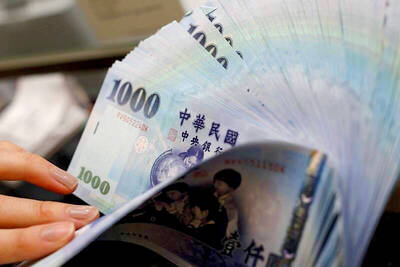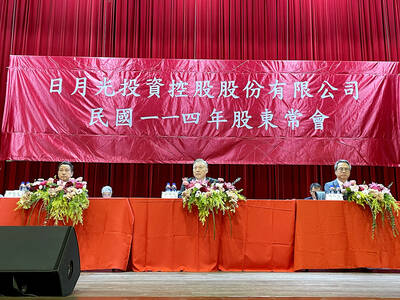To fend off competitors, Sony Ericsson Mobile Communications Ltd plans to widen its product portfolio this year, with camera phones incorporating Sony Corp's Cybershot brand name forming the centerpiece, a company executive said yesterday.
The Japanese-Swedish mobile phone maker is ranked the world's fifth-largest vendor, and occupies the No. 3 spot in Taiwan. But competition is intensifying both locally and globally as Korean vendors gear up to improve their market position.
"This year we will have a full range of products, including more low-end models and our secret weapon: camera phones under the Cybershot brand," Steven Yeh (

PHOTO: CNA
Last year, Sony Ericsson cemented its position in the music-phone market by launching the W-series of handsets under Sony's Walkman brand, Yeh said.
The firm sold a total of 3 million Walkman phones around the world last year, he said.
Building on that experience, Sony Ericsson is scheduled to introduce its first Cybershot camera phone, the K800 model, equipped with a 3.2 megapixel camera, in Taiwan next quarter, Yeh said.
"Sony's Cybershot digital cameras have gained popularity among consumers ... With the parent company's support, we will have enhanced strength to fight for a better market position," he said.
In addition to the high-end phones, the handset maker plans to roll out more clamshell models at lower prices this year to cater to local consumers' taste, Yeh said, without providing details.
In total, Sony Ericsson has pitched about 20 models in Taiwan since the beginning of the year, compared with a total of 13 models introduced last year, Yeh said.
He declined to reveal how many models the firm plans to launch this year.
Sony Ericsson expects these efforts to increase its slice of the nation's NT$45 billion (US$1.39 billion) mobile-phone market to more than 10 percent this year, from 6.7 percent last year, Yeh said.
"We are certain that Sony Ericsson will be able to safeguard the No. 3 spot this year," Yeh said.
Rival Seoul-based Samsung Electronics Co, which tracks closely behind Sony Ericsson, said last month that it aimed to seize the No. 3 spot in the local market by boosting its marketing budget by 50 percent.
Smaller local brand BenQ Corp (
Nokia Oyj and Motorola Inc, which between them hold about 50 percent of the domestic market, are in a close race for the No. 1 spot.

Merida Industry Co (美利達) has seen signs of recovery in the US and European markets this year, as customers are gradually depleting their inventories, the bicycle maker told shareholders yesterday. Given robust growth in new orders at its Taiwanese factory, coupled with its subsidiaries’ improving performance, Merida said it remains confident about the bicycle market’s prospects and expects steady growth in its core business this year. CAUTION ON CHINA However, the company must handle the Chinese market with great caution, as sales of road bikes there have declined significantly, affecting its revenue and profitability, Merida said in a statement, adding that it would

RISING: Strong exports, and life insurance companies’ efforts to manage currency risks indicates the NT dollar would eventually pass the 29 level, an expert said The New Taiwan dollar yesterday rallied to its strongest in three years amid inflows to the nation’s stock market and broad-based weakness in the US dollar. Exporter sales of the US currency and a repatriation of funds from local asset managers also played a role, said two traders, who asked not to be identified as they were not authorized to speak publicly. State-owned banks were seen buying the greenback yesterday, but only at a moderate scale, the traders said. The local currency gained 0.77 percent, outperforming almost all of its Asian peers, to close at NT$29.165 per US dollar in Taipei trading yesterday. The

RECORD LOW: Global firms’ increased inventories, tariff disputes not yet impacting Taiwan and new graduates not yet entering the market contributed to the decrease Taiwan’s unemployment rate last month dropped to 3.3 percent, the lowest for the month in 25 years, as strong exports and resilient domestic demand boosted hiring across various sectors, the Directorate-General of Budget, Accounting and Statistics (DGBAS) said yesterday. After seasonal adjustments, the jobless rate eased to 3.34 percent, the best performance in 24 years, suggesting a stable labor market, although a mild increase is expected with the graduation season from this month through August, the statistics agency said. “Potential shocks from tariff disputes between the US and China have yet to affect Taiwan’s job market,” Census Department Deputy Director Tan Wen-ling

UNCERTAINTIES: The world’s biggest chip packager and tester is closely monitoring the US’ tariff policy before making any capacity adjustments, a company official said ASE Technology Holding Inc (日月光投控), the world’s biggest chip packager and tester, yesterday said it is cautiously evaluating new advanced packaging capacity expansion in the US in response to customers’ requests amid uncertainties about the US’ tariff policy. Compared with its semiconductor peers, ASE has been relatively prudent about building new capacity in the US. However, the company is adjusting its global manufacturing footprint expansion after US President Donald Trump announced “reciprocal” tariffs in April, and new import duties targeting semiconductors and other items that are vital to national security. ASE subsidiary Siliconware Precision Industries Co (SPIL, 矽品精密) is participating in Nvidia